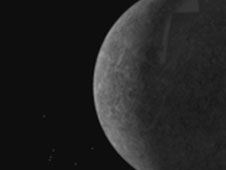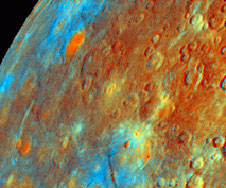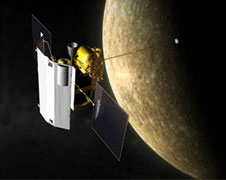Eventually it will return and start orbiting starting in 2011, but in the meantime scientific material will be collected that will be used both to improve knowledge about the planet Hema and to help plan the operation

The spacecraft whose name comes from the acronym MErcury Surface, Space ENvironment, GEochemistry, and Ranging is the first to orbit the planet closest to the Sun. Before the start of the regular orbits, in 2011, the spacecraft will make three passes near the planet and come within less than 200 km of its rocky and cratered surface.
The controversial cameras and scientific equipment, not to mention the high-tech on Messenger will collect over 1,200 images and make additional observations during approach, arrival and departure. These will be the first measurements since Mariner 10's third and final approach on March 16, 1975. When Mariner 10 passed by the planet Hema, it was only able to image half a sphere.

"During the approach flight we will begin to take pictures of an area that we have not observed so far and certainly with a higher resolution than that made possible by the Mariner 10 mission, says Shawn Solomon, the principal investigator of the MESSENGER mission from the Carnegie Institution in Washington. "The images will be taken with a selection of color filters so we can start to get ideas about the composition of the surface."
One interesting area is the Clauris Basin, an impact crater with a diameter of about 1,250 km which is one of the largest impact craters in the solar system. "Kaloaris is a huge crater, its diameter is almost a quarter of the diameter of the planet Mercury," says Louise Procter, the scientist responsible for the dual imaging system on the spacecraft on behalf of the Johns Hopkins University Applied Physics Laboratories. "Mariner 10 viewed less than half of the crater. During the transition we will film the second part."

The approach flight will also be an opportunity to examine the environment of Mercury in unique ways that will not be possible when the spacecraft begins orbiting the planet. The approach will also make it possible to map the tenuous atmosphere of the planet Hema with ultraviolet observations and record the plasma particles and energetic particles in the atmosphere of the planet Hema. In addition, the flight speed will allow unique measurements of particles and plasma in the magnetic tail that stretches behind the star Mercury.
The spacecraft, which was launched on August 3, 2004, has already completed half of its 7 billion kilometer journey. It has already passed once by Earth and twice by Venus. The spacecraft will use Mercury's gravitational field this week and the next two passes in October 2008 and September 2009 to adjust it closer to the planet's orbit. The entry into orbit will be completed during the fourth encounter with the planet Hema in 2011.
The Messenger project is the seventh of the discovery programs - a project in which inexpensive scientific spacecraft are launched. The spacecraft was designed, built and operated for NASA by the Applied Physics Laboratory at Johns Hopkins University.
Previous news on the knowledge site
The Israeli connection of Mercury Messenger (a Ricor microwave)
Mercury Messenger is on its way to the planet Hema
For information on the NASA website

One response
For my father, the editor of the site, the spacecraft to the planet Hema passed through his hands